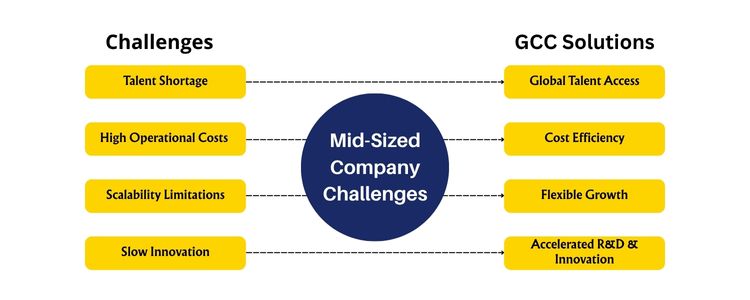
The Global Capability Center (GCC) model is no longer a prerogative of big businesses. It has turned out that mid-sized GCCs (500–2,000 employees) experienced an increase of 10-12% in hiring, more than twice the 4-6% expansion in larger GCCs (over 2,000 employees) in the same time period. This trend highlights the increasing rate of adoption of the GCC model by mid-sized firms that are keen on optimising operational performance and becoming global competitors.
Global Capability Center (GCC) is an offshore facility that is completely owned and managed by a parent company and a strategic center of core business operations like IT services, research and development (R&D), data analytics, and customer support. GCCs are not external outsourcing options as traditional ones are, but rather, long-term strategic innovation and business transformation arms of the parent company.
The mid-sized companies usually face a range of issues. Some basic issues are mentioned : These issues require solutions to be strategic in order to sustain growth and remain competitive.
Availability of Global Talent: GCCs allow companies to access a wide range of competent professionals, where they can access expertise in a particular field without being restricted by geographical boundaries. Cost Effectiveness: GCCs could be formed in areas where the cost of doing business is low, and this would result in huge savings. Eg: American organisations will have saved approximately 48 percent of software delivery expenses when compared to local specialists who have offshore development facilities. Scalability: GCCs scale the operations quickly to match the requirements of the business and to sustain the market. Localized Innovation: GCCs enable companies to innovate faster by grouping together their R&D efforts and capitalizing on global expertise to ensure that they remain competitive in the markets.
The economic implications of GCCs are high: Revenue Growth: The GCC market is expected to increase with the rate of 11.21 per cent to 110 Billion upto 2032. Employment Creation: In India, the mid-market GCCs comprise almost half of the entire GCC ecosystem, with an employed workforce of more than 220,000 professionals as of 2024. These statistics underscore the great economic dividend that GCCs are of to parent firms and the host countries.
It is recommended that mid-sized companies take into consideration the following steps in order to implement a GCC successfully:
In the future, it is likely that the role of GCCs will develop into: Such advances will further entrench the GCC model as an ingredient of global business strategy.
The implementation of the GCC model is a step towards attaining global competitiveness, operational effectiveness, and sustainable growth among the mid-sized companies. Through the opportunities created by GCCs, they can manoeuvre through the dynamics of the global market and emerge successful in the long run.
A GCC is an offshore facility of a multinational company that undertakes niche roles such as research and development, information technology service and strategic management. It is a government program that gives the women entrepreneurs up to 1 crore in bank loans to fund greenfield projects. Personal responsibilities and unconscious bias are the factors that lead to their mid-career attrition and slow them down in their careers. They introduce new ideas, understanding, and team-oriented leadership that speeds up the advancement of such areas as AI and cybersecurity. By 2030, women are expected to take up 25-30 per cent of GCC leadership positions, which will be paramount to the growth of the Indian market. Aditi, with a strong background in forensic science and biotechnology, brings an innovative scientific perspective to her work. Her expertise spans research, analytics, and strategic advisory in consulting and GCC environments. She has published numerous research papers and articles. A versatile writer in both technical and creative domains, Aditi excels at translating complex subjects into compelling insights. Which she aligns seamlessly with consulting, advisory domain, and GCC operations. Her ability to bridge science, business, and storytelling positions her as a strategic thinker who can drive data-informed decision-making.
Understanding the GCC Model
Difficulties of Mid-Sized Companies

GCCs Dealing With Challenges
Key Benefits of GCCs for Mid-Sized Companies
Benefit
Description
Access to Global Talent
GCCs enable mid-size firms to access extremely talented individuals in the fields of technology, finance, analytics and research. Through the GCC service model, firms are able to circumvent local talent deficiency and have a competitive advantage.
Cost Efficiency
Under the GCC framework, setting up an offshore development center (ODC) can lower the costs of operations and labour significantly, in most cases by 3050 per cent over onshore operations. It allows middle-scale businesses to invest further in expansion and innovation.
Scalability & Flexibility
GCCs allow scaling of teams, processes and technology according to the needs of your business. The medium-sized firms are able to expand or reallocate resources very fast without the infrastructure constraints of the traditional operations.
Accelerated Innovation
GCCs offer the option of scaling teams, processes and technology solutions as per the business needs. The medium-sized firms are able to expand or redistribute resources much faster without the infrastructural constraints of conventional operations
Enhanced Operational Efficiency
By offloading repetitive or specialised processes to a GCC, mid-sized companies can streamline internal workflows, improve productivity, and focus on strategic initiatives such as market growth, product innovation, and customer experience.
Economic Growth & ROI
GCCs also lead to visible economic gains such as increments in revenue, enhanced ROI, and reductions in costs. Also, through IR functions in areas with a good economic situation, firms can enjoy tax incentives and tax breaks and reduce compliance expenses.
Global Expansion Advantage
The GCC model facilitates international growth through the physical and operational presence in the strategic foreign markets. This assists mid-sized businesses to penetrate new geographies, gain local market knowledge and be able to scale their operations at low risk.
Economic Advantages of GCCs
Implementing GCCs in a Strategic Manner
GCCs in 2030
Conclusion
frequently asked questions (FAQs)

Aditi
Hey, like this? Why not share it with a buddy?
Related Posts
Recent Blog / Post
- Policy and the Multi-City GCC Grid: Catalyzing India’s Next Wave of Global Capability December 6, 2025
- BFSI GCC Digital Transformation: Moving from Back Office to Front-Line FinTech Innovation. December 6, 2025
- Pharma Global Capability Centers: Accelerating Drug Discovery with Computational Chemistry December 6, 2025
- Capability’ and ‘Sustainability’ as the New Twin Drivers of GCC 3.0 December 4, 2025
- Beyond Cost: Using Value-Per-Employee (VPE) as the New Metric for GCC Cost Optimisation. December 3, 2025
- From Cost Arbitrage to Global Chip Architect: Securing India’s Tech Future December 2, 2025
- The Great Reskilling Challenge: Preparing the Workforce for GCC Digital Transformation by 2025 December 2, 2025
- Semiconductor Geopolitics: The Strategic Impact on Automotive and Electronics Offshore Development Centers. December 1, 2025
- The GCC Innovation Centre Accelerating Digital Twins for Global Asset Modelling. December 1, 2025
- Gen AI in GCCs: Moving from Pilot Projects to Enterprise-Wide Industrialization. November 29, 2025
- The Evolution of GCC Security: From Perimeter Defence to Zero-Trust Architecture November 29, 2025
- Banking GCCs and the Rise of Open Finance Platforms November 27, 2025
- EdTech GCCs: Global Learning Labs for AI-Powered Education November 27, 2025
- Managing Compliance and Quality in the Gig Economy within a Captive Delivery Centre. November 26, 2025
- Implementing Zero-Trust: A Security Blueprint for Modern GCC Business Operations in India November 26, 2025
















